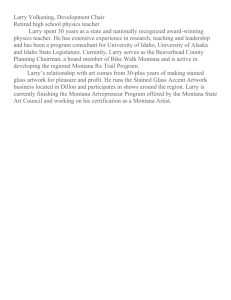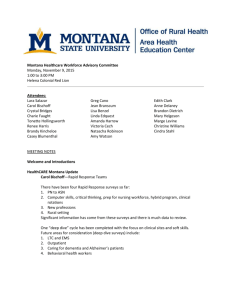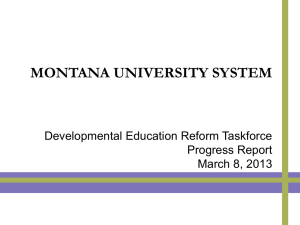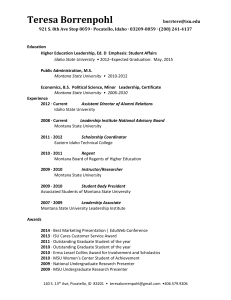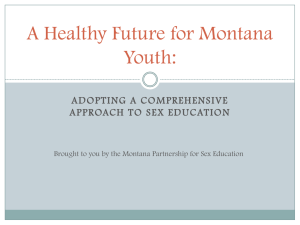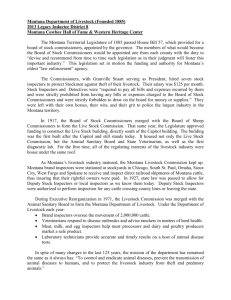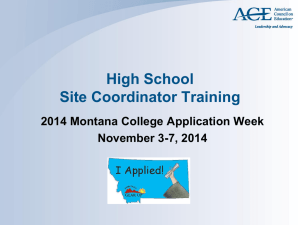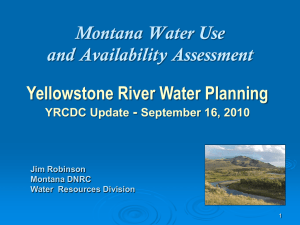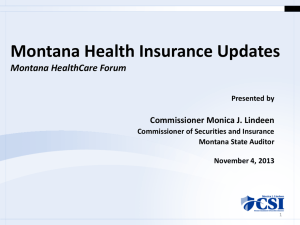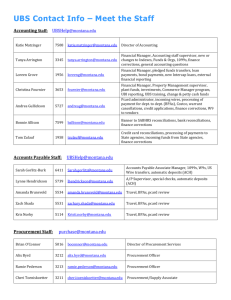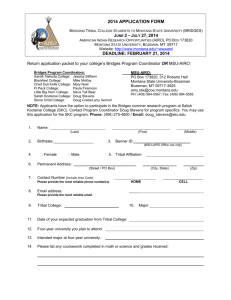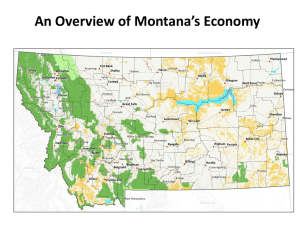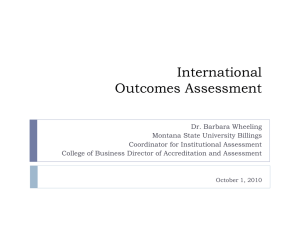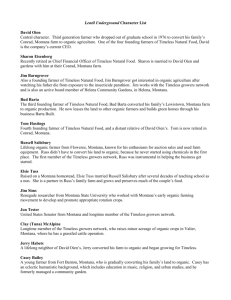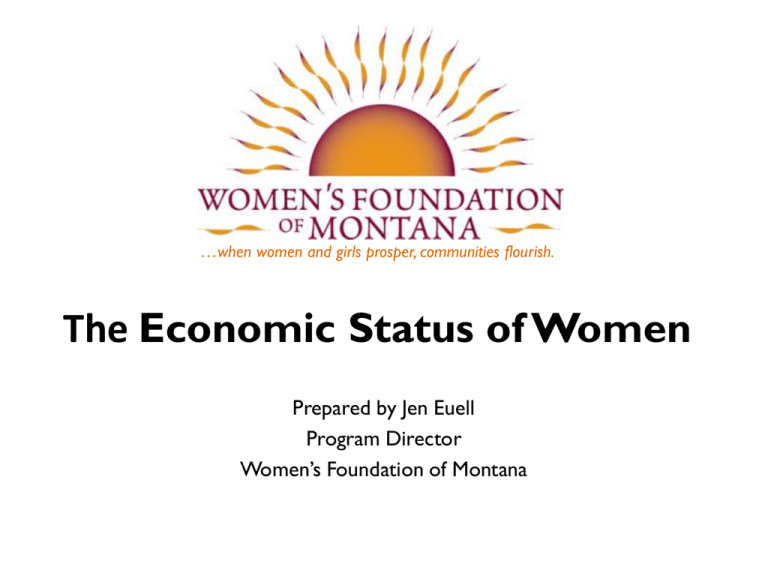
…when women and girls prosper, communities flourish.
The Economic Status of Women
Prepared by Jen Euell
Program Director
Women’s Foundation of Montana
"History is herstory too."
- Anonymous
A Short History of American Women
and Labor
• 1765 -The first society of working women,
the Daughters of Liberty is formed.
• 1824 -Women workers strike for the first
time, in Pawtucket, Rhode Island.
• 1825 -The first union for women only
formed: The United Tailoresses of New
York.
• 1872 - Congress passes a law giving
women federal employee equal pay for
equal work.
• 1916 - Jeannette Rankin (R-MT) became
the first women elected to the United
States House of Representatives. Ms.
Rankin served two terms in the House
from (1916-1918 and (1940-1942).
• 1917 - During WWI women's wartime
work in heavy industry and public service
jobs expanded women's roles in society.
• 1920- The Nineteenth Amendment to
the United States Constitution became
law, and women could vote in the fall
elections.
• 1920 - The Women's Bureau of the
Department of Labor is formed to collect
information about women in the
workforce and safeguard good working
conditions for women.
• 1941 - The shortage of workers
caused by WWII opens a wide range
of high-paying jobs to women.
Almost seven million women enter
the workforce, including two million
in heavy industry.
• 1961- President John Kennedy
establishes the President's
Commission on the Status of
Women and appoints Eleanor
Roosevelt as chairwoman. The
report issued by the Commission in
1963 documents substantial
discrimination against women in the
workplace and makes specific
recommendations for improvement,
including fair hiring practices, paid
maternity leave, and affordable child
care.
• 1963 - Congress passes the Equal Pay Act, making it illegal for employers
to pay a woman less than what a man would receive for the same job.
• 1964 - Title VII of the Civil Rights Act bars discrimination in employment
on the basis of race and sex.
• 1999 - The Supreme Court rules in Kolstad v. American Dental Association
that a woman can sue for punitive damages for sex discrimination.
• 2009 - President Obama signed the Lily Ledbetter Fair Pay Restoration
Act, which allows victims of pay discrimination to file a complaint with
the government against their employer within 180 days of their last
paycheck.
• Congress has yet to ratify CEDAW (The Convention on the Elimination of
All Forms of Discrimination Against Women).
American Women Today
• Women are marrying later and have
fewer children than in the past.
• Although more adult women live in
married couple families than in any
other living arrangement, an ever
growing number of women are raising
children without a spouse.
• More women are remaining childless,
although eight out of ten adult women
have children.
• As the baby boom generation ages, a
growing share of women and men are
older.
• The participation of women in the workforce rose dramatically through the
mid-1990s, but has been relatively constant since then.
• Workforce participation among men has declined, but women are still less
likely to work in the paid labor force than are men. When women do work,
they are much more likely than men to work part-time.
• Women continue to spend more of their time in household activities or
caring for other family members; they also do more unpaid volunteer work
than men.
• Despite their gains in labor market experience and in education, women
still earn less than men.
• Women are more likely to live in poverty than are adult men. Single mother
families face particularly high poverty rates, often because of the lower
wages earned by women in these families.
The Geography of Income
2010 Economic Indicators for Women
•
•
•
•
•
Median Annual Earnings = $36,000
Percent of Women in the Labor Force = 59.3%
Percent of Women in Professional Positions = 39.4%
Percent of Businesses that are Women-Owned = 28.7%
Percent of Women with a 4-year College Degree or Higher =
27.9%
• Percent of Women Living Above the Poverty Level = 84.9%
• Percent of Women with Health Insurance = 81%
The Gender Earnings Ratio,
1955–2011, Full-Time Workers
The Economic Status of Women in
Montana
• Rural
• Traditionally Dominated by Extractive Industry
and Agriculture
The Pay Gap
• In the United States,
women’s wages continue
to lag behind men’s
• Montana women’s earn
an average of $31,137, the
4th lowest in the nation
Poverty
• Montanans are more likely to be
poor, compared with the rest of
the nation, and women are more
likely to be poor than men
• 42.5% of Montana children living
in a household headed by a lone
mother live in poverty
Education
• Women’s increased education does not necessarily
translate to higher earnings, compared with male
earnings.
• Women with a high school education earn less than
men without, and the same is true for each level of
education, with the exception of a doctorate.
.
The Cost of Childcare
• Although the income of
Montana’s women is the fourth
lowest in the United States, the
cost of child care is the 22nd
highest
• the average annual cost of child
care for one child in Montana is
approximately $8,000, more
than half the poverty threshold
for a one-parent, one-child
family of $15,825
Access to Healthcare
• Statewide, Montana ranks close
to the national percentage: 19%
of women are without health
insurance
• Forty-nine percent of Montana
women live in counties that lack
safe abortion services compared
with 35% of women nationally
Safety
Elderly In Montana
• Older women are more reliant on Social Security and more
likely to be living in poverty
•
Montana men 65 and older, living alone, have a median
income of $22,800, with Social Security representing about
53% of their income, Montana women elders live on $17,700,
and Social Security is 72% of this
The Status of American Indian Women
• American
Indian women
fare worse on
virtually every
indicator
American Indian Women
• 34% percent of American Indian and Alaska Native women
will be raped in their lifetimes and 39% of American Indian
and Alaska Native women will be subjected to domestic
violence in their lifetimes
• American Indian women have a greater incidence of high
blood pressure, a major risk factor for heart disease, stroke
and heart failure
• 17% of American Indian women obtain their bachelor’s
degree, compared with over 20% of the total Montana
population.
The Good News…….
• Montana women are educated
• Montana women vote
• Montana women lead
What We Can Do
• Regularly evaluate wages and promotion
practices
• Better policies and benefits for women workers
• Encourage women to move into “nontraditional” work
• Invest in financial education and wage
negotiation training for women
• Increase resources for women in business and
entrepreneurship
• Recruit women to run for office
What the WFM Will Do
• Research and educate on the economic
barriers and opportunities for women & girls
• Convene strategic partners to create solutions
and advocate for social and systemic change
• Connect women and organizations with
resources and information
• Foster leadership among women and girls
• Raise funds and grow our endowment in
support of women and girls
What You Can Do
•
•
•
•
•
Consider women’s issues when you vote
Invest in organizations that support women
Organize, advocate, lobby!
Learn to negotiate for your own best pay
Leadership starts with you! Run!

